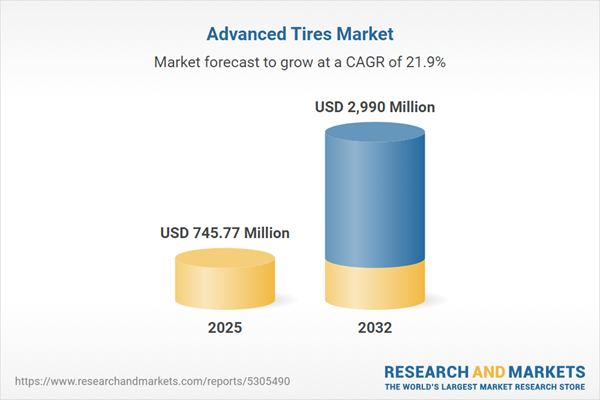Speak directly to the analyst to clarify any post sales queries you may have.
The advanced tires market is undergoing significant transformation, with a growing emphasis on intelligent technology and digital solutions influencing both operational performance and strategic planning in the automotive sector. Senior decision-makers face evolving challenges that demand agile responses across supply chains, compliance, and fleet management.
Market Snapshot: Advanced Tires Market Size and Growth Dynamics
In 2024, the advanced tires market reached a valuation of USD 612.36 million, with projected growth to USD 745.77 million by 2025 at a CAGR of 21.94%. Expansion to USD 2.99 billion is forecast for 2032, driven by rapid adoption of smart tire solutions and integration of digital connectivity. Advanced tire technologies now play a pivotal role in optimizing safety, asset management, and procurement for both commercial and passenger vehicle sectors. Companies are leveraging data analytics and automation to refine fleet operations and deliver improved outcomes in competitive transport, industrial, and logistics environments.
Scope & Segmentation of the Advanced Tires Market
This report targets executives seeking actionable insights into the advanced tires market, detailing segment dynamics and relevant adoption drivers. It outlines how regulatory changes and emerging technologies shape procurement, research, and fleet operations across industries, equipping leaders for structured strategy development.
- Vehicle Types: Analyses commercial fleets such as trucks and buses alongside passenger vehicle categories, informing approaches for mobility strategy and aftermarket support across diverse business models.
- Tire Construction: Compares bias and radial construction, illustrating connections to operational reliability, longevity, and maintenance efficiency, especially in challenging work environments.
- Tread Patterns: Evaluates symmetric, asymmetric, and directional tread designs, highlighting their influence on factors like fuel efficiency, traction, and suitability for variable road or climate scenarios.
- Distribution Channels: Examines original equipment manufacturer (OEM) and aftermarket channels, with analysis of increased digital platform adoption and changing service models that reinforce supply chain effectiveness.
- Applications: Reviews use cases in highway transport, agriculture, mining, and construction, focusing on how advanced tires help minimize equipment downtime and operational risk exposure.
- Regional Coverage: Assesses demand drivers and purchasing trends in North America, Latin America, Europe, Middle East, Africa, and Asia-Pacific, with specific attention to commercial activities in major economies such as the US, China, Germany, Brazil, India, and South Africa.
- Companies Profiled: Details competitive approaches and product innovation from key industry players including Bridgestone, Michelin, Goodyear, Continental AG, Pirelli, Hankook Tire & Technology, Yokohama Rubber, Sumitomo Rubber Industries, Toyo Tire, and Apollo Tyres, showcasing project management and market positioning strategies.
Key Takeaways for Senior Decision-Makers
- Sensor-enabled data analytics are enabling predictive maintenance to sustain fleet performance, cut unplanned downtime, and uphold operational continuity.
- Strategic partnerships among manufacturers, technology providers, and OEMs support the swift integration of digital capabilities, enabling service models that accommodate shifting operational requirements.
- The increased utilization of renewable and recycled materials within tire production aligns with advancing sustainability mandates and compliance goals set by procurement leadership.
- Establishing manufacturing near high-demand regions enhances supply chain responsiveness to evolving market and regulatory landscapes.
- Introduction of production automation is elevating product reliability, supporting quality assurance, and reducing dependency on manual oversight.
- Diversified supplier networks are improving resilience, allowing organizations to maintain access to materials and sustain consistent operations amid demand fluctuations and global uncertainty.
Tariff Impact: Adapting to Policy Shifts and Global Trade Dynamics
Changing tariff structures and international trade policies are prompting companies in the advanced tires sector to re-evaluate supplier portfolios and manufacturing locations. Senior procurement teams are prioritizing risk management strategies to mitigate supply disruption, ensuring cost-effectiveness and flexibility in response to policy adjustments and regulatory developments within global markets.
Methodology & Data Sources
Findings in this report are derived from interviews with senior industry executives and comprehensive secondary research. Analytical frameworks including SWOT, PESTEL, and Porter’s Five Forces were used to examine sector challenges, growth drivers, and the competitive environment in the advanced tires market.
Why This Report Matters: Strategic Decision Support for the Advanced Tires Market
- Enables alignment of advanced tire and sustainability initiatives with current industry shifts to support business continuity and forward-looking planning.
- Presents executive analysis of regional compliance requirements, providing the foundation for proactive adaptation to complex regulatory environments.
- Guides organizations in implementing digital transformation and updating tire management practices for industrial, logistics, and mobility operations.
Conclusion: Charting the Path Forward in Advanced Tires
With focused analysis, senior leaders can make informed, strategic choices that strengthen their organizations through regulatory shifts, technological evolution, and new operational challenges in the advanced tires market.
Additional Product Information:
- Purchase of this report includes 1 year online access with quarterly updates.
- This report can be updated on request. Please contact our Customer Experience team using the Ask a Question widget on our website.
Table of Contents
3. Executive Summary
4. Market Overview
7. Cumulative Impact of Artificial Intelligence 2025
Companies Mentioned
The companies profiled in this Advanced Tires market report include:- Bridgestone Corporation
- Michelin S.E.
- The Goodyear Tire & Rubber Company
- Continental AG
- Pirelli & C. S.p.A.
- Hankook Tire & Technology Co., Ltd.
- Yokohama Rubber Co., Ltd.
- Sumitomo Rubber Industries, Ltd.
- Toyo Tire Corporation
- Apollo Tyres Ltd.
Table Information
| Report Attribute | Details |
|---|---|
| No. of Pages | 182 |
| Published | November 2025 |
| Forecast Period | 2025 - 2032 |
| Estimated Market Value ( USD | $ 745.77 Million |
| Forecasted Market Value ( USD | $ 2990 Million |
| Compound Annual Growth Rate | 21.9% |
| Regions Covered | Global |
| No. of Companies Mentioned | 11 |









